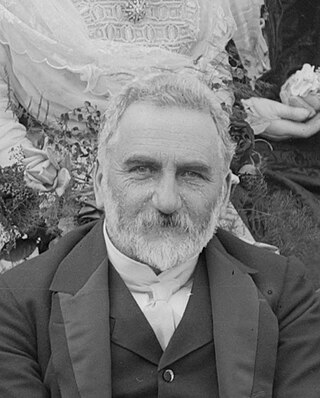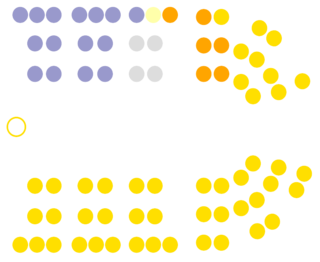Related Research Articles
The 2nd New Zealand Parliament was a term of the Parliament of New Zealand. It opened on 15 April 1856, following New Zealand's 1855 election. It was dissolved on 5 November 1860 in preparation for 1860–61 election. The 2nd Parliament was the first under which New Zealand had responsible government, meaning that unlike previously, the Cabinet was chosen by Parliament rather than by the Governor-General of New Zealand.

Nelson is a New Zealand parliamentary electorate, returning one Member of Parliament to the House of Representatives of New Zealand. From 1853 to 1860, the electorate was called Town of Nelson. From 1860 to 1881, it was City of Nelson. The electorate is the only one that has continuously existed since the 1st Parliament in 1853.

Thomas William Hislop was the Mayor of Wellington from 1905 to 1908, and had represented two South Island electorates in the New Zealand Parliament.

Waitaki is an electorate for the New Zealand House of Representatives that crosses the boundary of North Otago and South Canterbury towns on the East Coast of the South Island. The electorate was first established for the 1871 election that determined the 5th New Zealand Parliament. It has been abolished and re-established several times and in its early years was a two-member electorate for two parliamentary terms. The current electorate has existed since the 2008 election and is held by Miles Anderson of the National Party.

Waikato is an electorate in the New Zealand Parliament. A Waikato electorate was first created in 1871 and an electorate by this name has existed from 1871 to 1963, 1969 to 1996, and 2008 to the present, though exact borders have often changed.
Manukau is a former New Zealand parliamentary electorate in the south Auckland Region. It existed from 1881 to 1978, with a break from 1938 to 1954. It was represented by nine Members of Parliament. Two by-elections were held in the electorate.
Riccarton is a former New Zealand parliamentary electorate. It existed from 1893 to 1978, and was represented by eight Members of Parliament.
Waihemo is a former parliamentary electorate in the Otago region of New Zealand. It existed for two periods and was represented by two Members of Parliament.
Taieri is a parliamentary electorate in the Otago region of New Zealand, initially from 1866 to 1911, and was later recreated during the 2019/20 electoral redistribution ahead of the 2020 election.
Pareora was a former parliamentary electorate in the Canterbury region of New Zealand for one electoral term in the 19th century.
Mount Ida is a former parliamentary electorate in the Otago region of New Zealand, from 1871 to 1893, and then from 1902 to 1908.
Westland was a parliamentary electorate in the West Coast of New Zealand from 1866 to 1868 and 1890 to 1972. In 1972 the Tasman and West Coast electorates replaced the former Buller and Westland electorates.
Linwood was a parliamentary electorate in Christchurch, New Zealand, from 1887 to 1890. The electorate was represented by one Member of Parliament, Andrew Loughrey.
Roslyn was a parliamentary electorate in the city of Dunedin in the Otago region of New Zealand from 1866 to 1890.
Oamaru was a parliamentary electorate in the Otago region of New Zealand, during three periods between 1866 and 1978.

Samuel Edward Shrimski was a 19th-century Member of Parliament and then a Member of the Legislative Council from Otago, New Zealand.
The 8th New Zealand Parliament was a term of the New Zealand Parliament.
The 10th New Zealand Parliament was a term of the Parliament of New Zealand. Elections for this term were held in 4 Māori electorates and 91 European electorates on 7 and 26 September 1887, respectively. A total of 95 MPs were elected. Parliament was prorogued in October 1890. During the term of this Parliament, two Ministries were in power.

The 12th New Zealand Parliament was a term of the New Zealand Parliament. It was elected at the 1893 general election in November and December of that year.

The 15th New Zealand Parliament was a term of the New Zealand Parliament. It was elected at the 1902 general election in November and December of that year.
References
- ↑ Scholefield 1950, p. 161.
- ↑ McRobie 1989, pp. 67f.
- ↑ Scholefield 1950, p. 94.
- 1 2 "The General Election, 1902". National Library. 1903. p. 2. Retrieved 8 February 2012.
- ↑ Cyclopedia Company Limited (1897). "Advances To Settlers Office". The Cyclopedia of New Zealand : Wellington Provincial District. Wellington: The Cyclopedia of New Zealand . Retrieved 7 February 2012.
- ↑ Chalklen, Mollie. "John Crewes". Dictionary of New Zealand Biography . Ministry for Culture and Heritage . Retrieved 11 December 2011.
- ↑ "The General Election, 1905". National Library. 1906. p. 3. Retrieved 8 February 2012.
- ↑ Appendix to the Journals of the House of Representatives. New Zealand: New Zealand Parliament. 1906. p. 3.